Search
[{{{type}}}] {{{reason}}}
{{/data.error.root_cause}}{{{_source.title}}} {{#_source.showPrice}} {{{_source.displayPrice}}} {{/_source.showPrice}}
{{#_source.showLink}} {{/_source.showLink}} {{#_source.showDate}}{{{_source.displayDate}}}
{{/_source.showDate}}{{{_source.description}}}
{{#_source.additionalInfo}}{{#_source.additionalFields}} {{#title}} {{{label}}}: {{{title}}} {{/title}} {{/_source.additionalFields}}
{{/_source.additionalInfo}}Duskers (PC)

Duskers
Developed By: Misfits Attic
Published By: Misfits Attic
Released: May, 8, 2016
Available On: Windows, Mac, Linux (via Steam)
Genre: Rogue-like strategy survival
ESRB Rating: Not provided
Number of Players: 1 offline
Price: $19.99
(Humble Link)
Have you ever seen a sci-fi film where there is only a single protagonist, alone in the vast emptiness of space? No other human interaction, their only companion a robot or two with no human speech capabilities. Having to survive dangerous hazards; radiation breaches, meteor strikes and hostile robots and aliens. Claustrophobic, confined to a small spaceship with the same looking corridors and rooms. Fear of no one else to rely upon.
It’s a start, though I haven’t even begun to convey the feelings that Duskers brings out.
You are a drone operator on a space ship. You are all alone. Something happened that turned the universe into a giant graveyard. Wrecks of spaceships and stations are abundant in every solar system you see. You need to survive for as long as you can and these wrecks are the only source of resources required for survival.
Start up the game and you immediately get the vibe. It’s like booting up a terminal from an 80’s sci-fi film, whirring and clicking with some kind of display grain included. Starting up a new game and you are thrown into a system view with several wrecks which you can travel to, using available propulsion fuel, then board to scavenge for more resources to be used to do more travelling, repair degrading equipment and upgrading your drones.
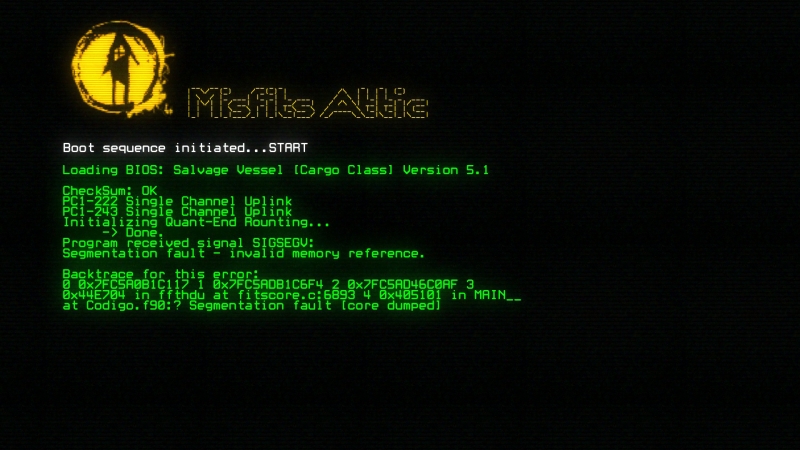
Strong Points: Played through an 80s sci-fi stylised terminal with visual and command line interface; vector based graphics design with visual artefacts mixed with retro and realistic sounds adding to the immersion.
Weak Points: Slow paced and a need to learn a varied list commands to pilot your drones effectively; no music.
Moral Warnings: Foul language (PG-13 equivalent) found in text logs scattered throughout the game world.
The boarding is done via drones, as these wrecks are potentially too dangerous for a (sole surviving?) human to risk their life investigating. Starting off with three drones, you board a wreck and investigate the wreck room by room, all of which are connected via doors. The problem is you don’t know what is on the other side of the room if the door is closed. Opening a door and wandering through is an option which more than likely would potentially cause a hazardous or hostile encounter in the room, unwittingly disabling your drone(s). Lose all your drones or run out of fuel with no way to proceed further and you will need to perform a reset to start your adventure over again, losing the resources you scavenged from those many wrecks.
To increase their usefulness in scavenging wrecks, your drones are given loadouts with the potential of having three upgrades installed per drone. Upgrades come in various types allowing drones to; gather resources, scan rooms for hostiles or hidden salvage, become invisible, increase speed, tow drones and ship modules, teleport in to other rooms, etc.
After you have salvaged all you can from a wreck, leave, find another wreck and repeat. However, more depth is provided via Objectives.
There is a story in the game and that story is unwrapped via text logs found by boarding wrecks. These logs could be personal logs to engineering, military or scientific reports. Not all wrecks have logs to discover, though when they do there is a chance for an additional objective to be added to your primary ‘survive’.
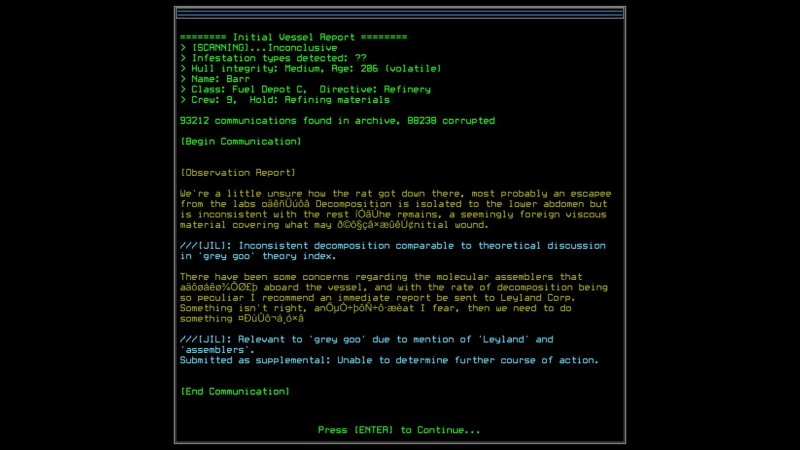
Higher is better
(10/10 is perfect)
Game Score - 80%
Gameplay - 15/20
Graphics - 9/10
Sound - 8/10
Stability - 5/5
Controls - 3/5
Morality Score - 85%
Violence - 6.5/10
Language - 6/10
Sexual Content - 10/10
Occult/Supernatural - 10/10
Cultural/Moral/Ethical - 10/10
One example I have come across was from a medical transport wreck talking about pathogens and quarantined wrecks, with an objective to capture an organic hostile.
I don’t know if I have come across any biological organisms; I’ve certainly come across some slow moving hostiles and some so fast that you blink and your drone is dead. I’ve seen hostile in the form of drones similar to yours, and organic-like swarms. Though I’ve only been able to glean so much in the time it takes them to disable my drone before the drone view is cut off.
What I do know about these hostiles is they like to roam around. If they are in a room with all doors closed, they have nowhere to go. Provide them with an open door and they will happily explore, back and forth, always moving, never resting. Use that to your advantage. This simple logic allows you to lead these hostiles in to other rooms or away from the room where you want to explore, or in to a devised trap. Just make sure you can keep track of their movements using motion detectors and sensors as they do not always move around in a predictable manner.
While you may feel safe in a room with a locked door, they do not provide 100% security between your drones and any hostiles. I have witnessed doors come under attack from enemies, even though I am nowhere near them, perhaps these hostiles get restless and have the need to move. Once a door is destroyed they are wide open for hostiles to freely move through. If you see a vent, listen for any strange noises, there could be a swarm coming down the ventilation shaft.
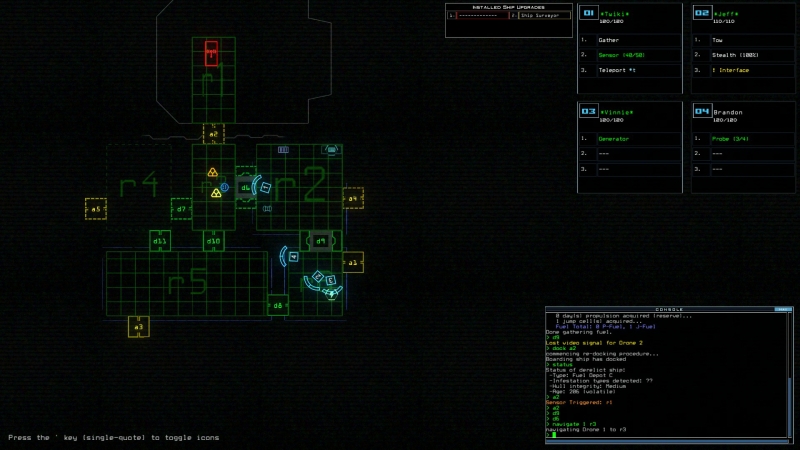
Some wrecks have terminals which can be accessed by a drone, so long as they have an interface module installed. These terminals allow you to scan the ship to discover all the rooms inside the wreck, including any hidden salvage that would not be normally found by your drone. They can also activate or deactivate defence turrets, if they are installed on the wreck.
Defence turrets are cool and demand your total respect. They are stationary platforms confined to a room of their own and can make quick work of any target that comes across its path. When I say any target that also includes your own drones; there is no friend or foe recognition. Turrets will obliterate anything that happens to wander inside the room its defending. Used wisely and they can be used to lure and destroy any hostiles lurking inside other rooms; become complacent and you are likely to lose a drone or two.
Sound effects are not there for mere cosmetic value; they provide audio cues to your surroundings. Different sound effects can be heard depending on which view you are in. In schematic view you hear more global noise, creaks, groans and clangs. Switch to drone view and you can hear more local sound effects, the whirring of moving drones and perhaps the buzzing of a swarm. These sound effects really add to the atmosphere of the game, adding to the element of horror and tension. In one game I was in schematic view, ordering my drones around and a large creaking shuddered throughout the ship. I figured it only added to the immersion of being on-board an unstable wreck. A moment later, a room flooded with radiation. A room containing two of my three drones. Both drones swimming in radiation, irretrievable, and forever lost.
The whole game is controlled solely through the keyboard, using arrow keys to navigate menus and a command line interface to issue orders to your drones. There is no joypad support, nor would an implementation be appropriate as you need to type out your commands. When investigating wrecks; drones, rooms and doors are all labelled for easy reference. You type your commands to instruct your drones to move or perform other actions, such as gathering resources or towing disabled drones and ship parts, etc. To speed up the typing there is a slight auto-complete feature (predict-a-text) to guess the command you are typing, increasing efficiency by relieving you from having to type out the whole command name.
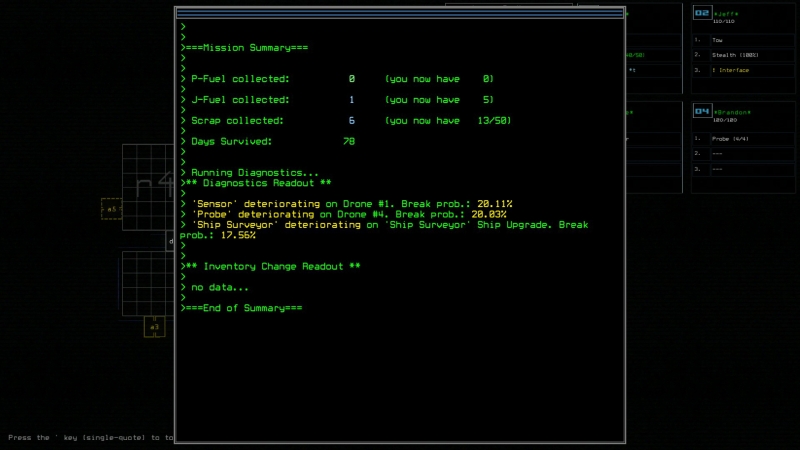
A downside to the command line interface is typing similar commands over and over again. Like instructing a drone to navigate in to a room and then to salvage anything that is inside. Relax, though, there is a solution.
Aliases, think custom macros or a set of commands that can be rolled into a single command to increase efficiency. For example, in the previous scenario you could create a “collect “ alias which would contains two commands “navigate 1; r1 gather”, commanding Drone 1 to move into room 1 and collect any scrap lying around the room. This can then be improved by specifying a variable, changing the alias into “navigate 1 $; gather”, to navigate to any room or through any door and gather the resources, i.e. “collect r3” or “collect d5”.
Variables in aliases are a new feature to Duskers, something that was added in recent months, that was not present on release. It just shows that the developer is still active in making quality of life improvements for the drone operator.
Every time your ship or drone uses a module on a mission it increases the chance to break. A RNG (Random Number Generator) mechanic that feels completely random that can work for you or against you (XCOM anyone?). At the end of a mission a module's break probability increases. A “!” indicator also warns when the probability is considered too high. Sounds cool, though in my playthroughs I’ve wasted what little scrap I’ve gathered in repairing certain modules when they have only been used on 4 or 5 missions; the repair cost is constant no matter the amount of wear. The reason I’ve repaired them so frequently is that once a module reaches 15% there is a good chance it will break on the mission. Then, when the module breaks it cannot be repaired and must be scrapped for a single scrap unit.
If you have a good scrap haul you can upgrade your modules and increase their uses. I was able to try out the upgrade from the teleport module; the basic version just teleports the drone it’s fitted too, where the upgraded can teleport droppable items. I was able to use this feature to teleport sensors in other rooms and even a bomb to destroy a trapped hostile. A couple of other modules can be upgraded to have a clamp, preventing the drone from being sucked outside of a room. Other module upgrades allow more uses from a finite pool, i.e. the drone or sensor module. Making use of these upgrades can certainly change up the gameplay and make it easier to gather valuable resources from wrecks.
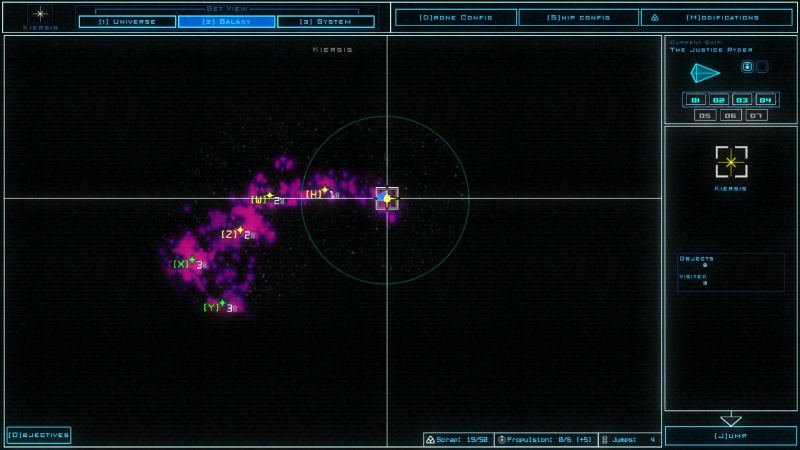
All of this gameplay takes place inside a system, in a galaxy within a universe. For which there are several of each. Travelling from system to system uses your jump fuel. To travel to another galaxy you use a jump gate, which can be found in a system. I’m not certain if I traversed to another universe, though I vaguely recall using another type of jump gate (as I’ve only done that once in another playthrough several months ago). Providing universes in this way gives a sense and feeling of exploring the unknown; you have a limited view of systems to travel to and can only uncover other galaxies and universes by exploring.
For those who enjoy scoreboards there are daily and weekly challenges, removing the story and objective based elements. To complete these challenges you need to use a jump gate with the aim of gaining a higher score than other players, indicating how well you did in that playthrough. It’s a simple addition which will keep those interested in competing coming back and acts as an alternative to playing the main objective and story based game.
It was a bit hard to determine the morality, given that the text logs presented are randomly presented. After searching through the games assets file containing these text logs, I was able to verify that foul language is used infrequently (to the extent of PG-13) and I did find one instance of blasphemy (using or our Lord and Saviours name in vain). Dusker does not center on violence, instead focusing on the exploration and scavenging of resources, whilst minimising hostile encounters. Different types of weapons are provided to destroy non-organic and organic threats; there is no evidence of blood by doing so and the remains of the dead hostile stay in the level.
Overall, Duskers is a slow-paced game providing opportunities for tactical thinking and execution, which can be spurred on by random events which can quite easily ruin the best laid out plans. The graphics has its own unique style and is effective and contrasting to look at. Sound, while limitedly used (other than the constant background hum) is used to good effect, providing audio cues to your surroundings and adds to the loneliness and tension of being aboard an abandoned (and potentially unstable) wreck. There are a lot of gameplay elements to figure out, which can be expanded further via upgrades, adding to the longevity. While there are a lot of commands to learn, which raises the barrier for entry to those new to the game, there is a very handy help feature listing the commands and provides further help.
Daniel I.B. Woods (aka centaurianmudpig)








